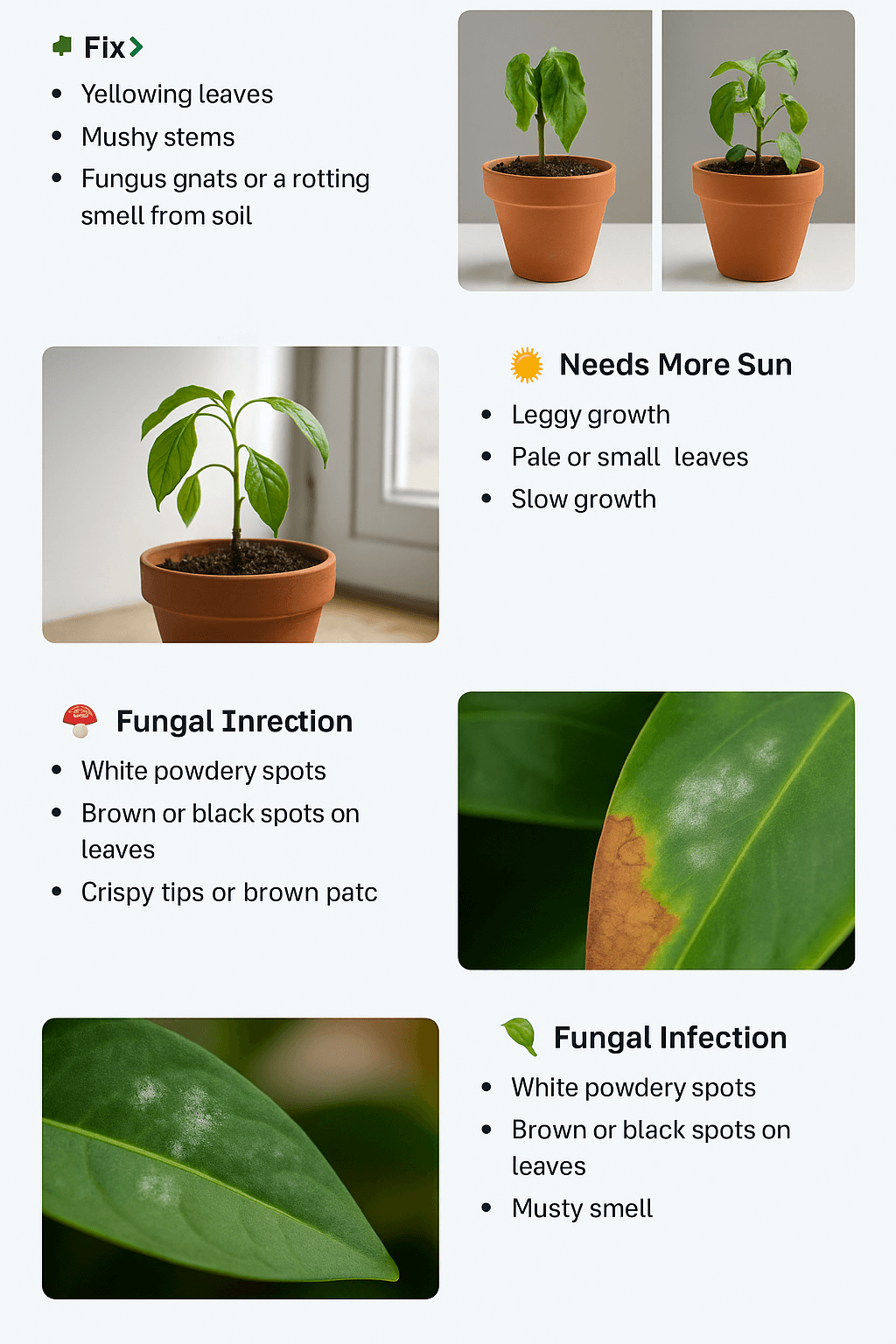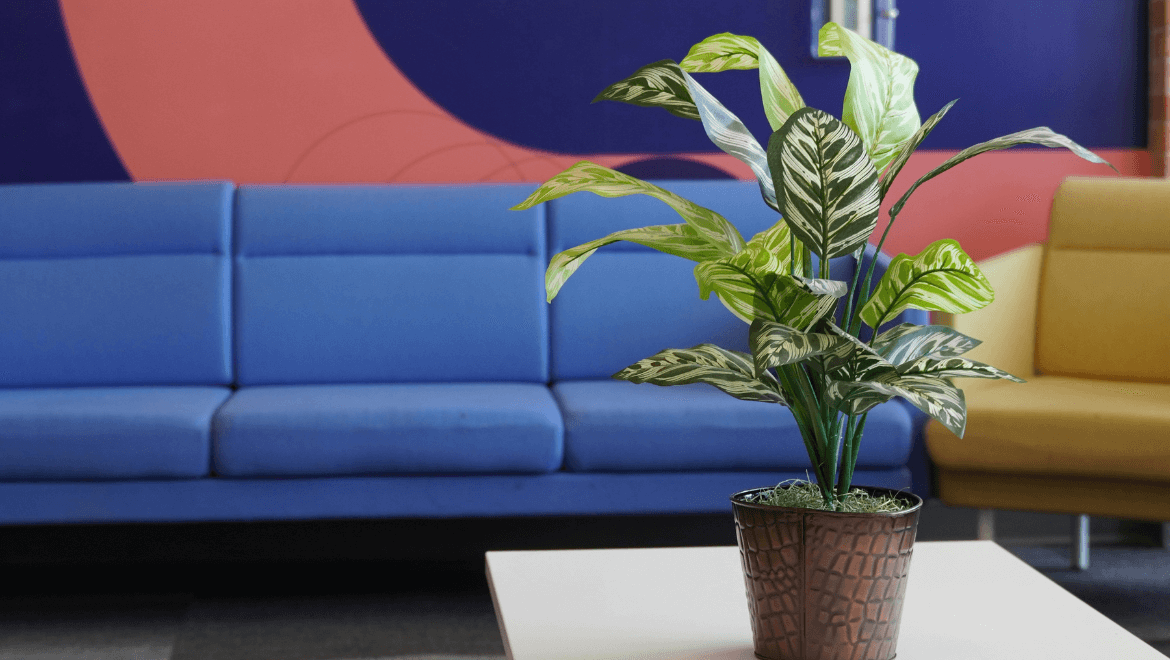- Your cart is empty
- Continue shopping
6 Signs Every Plant Parent Must Know (With Fixes)
Being a plant parent is more than just watering once a week. Your plants have subtle ways of communicating with you — and when you start paying attention, you’ll notice they’re constantly trying to tell you something.
Below are six common plant signals decoded with solutions, images, and an easy-to-follow checklist to help your indoor jungle thrive.
1. Needs More Water
Common Symptoms:
- Leaves appear droopy, curling downward.
- Leaf tips or edges look brown and crisp.
- Soil feels dry and compacted an inch or more down.
- Plant seems lighter when picked up (dry pot).
Why It Happens:
- High heat or indoor AC dries soil quickly.
- Overhead watering isn’t reaching deep roots.
- Small pots lose moisture faster.
How to Fix It:
- Use the finger test: insert a finger 1-2 inches deep — if dry, water thoroughly.
- Try bottom watering for 20-30 minutes.
- Group plants together to maintain ambient humidity.
👉 Many new plant parents often wonder how much water do plants need, and the truth is it varies by plant type, season, and environment.
2. Needs Less Water
Common Symptoms:
- Leaves yellow from bottom up.
- The stem base feels mushy or soft.
- Soil is constantly wet and may smell foul.
- You spot fungus gnats buzzing around.
Why It Happens:
- Over-loving your plant with too much care.
- No drainage holes in the pot.
- Watering on a fixed schedule without checking moisture.
How to Fix It:
- Allow soil to fully dry out before the next watering.
- Repot using well-draining soil (add perlite or sand).
- Trim off any rotting roots and remove yellow leaves.
- Use terracotta pots that breathe better.
3. Needs More Sun
Common Symptoms:
- Leggy growth: stems stretch and lean toward light.
- Leaves are smaller, thinner, or lighter in color.
- Plant grows unevenly or not at all.
Why It Happens:
- Kept too far from a light source.
- North-facing rooms or cloudy weather.
- Using opaque curtains or pots that block light.
How to Fix It:
- Move plant to a bright spot (south or east window).
- Rotate weekly for even growth.
- Invest in a grow light if natural light is limited.
👉 Certain sun loving plants thrive best in full light, so knowing your plant’s preference is key.
4. Needs More Shade
Common Symptoms:
- Leaf scorch: white, faded, or brown patches.
- Wilting in the afternoon despite moist soil.
- Leaves feel thin or translucent.
Why It Happens:
- Placed under direct sun when plant prefers indirect.
- Windows magnify light intensity.
- Too much exposure for too long (especially summer).
How to Fix It:
- Move plant away from harsh direct light.
- Filter sun using sheer curtains.
- Relocate to indirect light spot, especially for Calatheas, Ferns, etc.
👉 If you have plants that need shade, watch out for crispy or faded leaves as an early warning.
5. Fungal Infection
Common Symptoms:
- White powder or gray fuzz on leaves or soil.
- Brown, black, or rust-colored leaf spots.
- Plant smells musty or earthy.
- Leaf edges appear wet or slimy.
Why It Happens:
- High humidity with poor airflow.
- Dirty or reused pots and tools.
- Leaves staying wet for too long after watering.
How to Fix It:
- Prune infected leaves immediately.
- Use organic fungicides (neem oil, baking soda spray).
- Increase ventilation; use fans in humid rooms.
- Avoid misting in poorly ventilated spaces.
👉 A fungal infection in plants can spread quickly, so early detection is essential.
6. Physical Injury or Transplant Shock
Common Symptoms:
- Leaves fall suddenly after repotting or moving.
- Bent or torn leaves.
- Browning on leaf edges even though care is consistent.
- Slowed growth or “stalling.”
Why It Happens:
- Rough handling during transport or repotting.
- Change in temperature or environment.
- Over-pruning or overwatering right after repotting.
How to Fix It:
- Give your plant a few days to adjust post-repot.
- Increase humidity to help reduce stress.
- Avoid fertilizing for at least 3 weeks after repotting.
- Be gentle when pruning or rotating pots.
👉 Some drought tolerant plants recover from stress more easily than others due to their natural resilience.

Quick Plant Health Checklist
✅ Check soil before watering
✅ Ensure proper light exposure
✅ Maintain good air circulation
✅ Inspect leaves for spots or pests
✅ Use pots with drainage holes
✅ Track watering and repotting dates
✅ Rotate plants weekly for even growth
✅ Mist or humidify for tropical plants
✅ Watch for signs of stress or infections
Frequently Asked Questions (FAQs) About Your Plant Health
1. What does it mean when my plant’s leaves are turning yellow?
Yellowing leaves can indicate overwatering, poor drainage, or even nutrient deficiency. If the lower leaves are affected and soil feels wet, it’s likely due to too much water. Let the soil dry and avoid watering on a rigid schedule.
2. How do I know if I’m overwatering my houseplant?
An overwatered plant typically has soft, mushy stems, constant soil dampness, and a rotting smell. Use a pot with drainage holes, and water only when the top inch of soil is dry.
3. My plant looks stretched out and leggy. Is it getting enough light?
A leggy plant is reaching for more light. Move it to a brighter spot, ideally a south-facing window, or consider using a grow light for optimal indoor plant care.
4. What causes brown, crispy leaf tips?
This could be due to low humidity, over-fertilization, or even salt buildup from tap water. Try using distilled water and misting the plant regularly, or group plants to increase humidity.
5. How can I tell if my plant needs more shade?
Signs of too much direct sun include faded leaves, white sunburn patches, or crispy edges. Shade-loving plants like ferns or calatheas do best in filtered or indirect sunlight.
6. What are common signs of fungal infections in houseplants?
Look for white powdery spots, black or brown dots on leaves, or a musty smell. Remove infected parts and spray neem oil or a natural antifungal. Improve air circulation and reduce humidity levels.
7. Can moving a plant cause it to go into shock?
Yes! Transplant shock or environmental stress can cause sudden leaf drop or wilting. Minimize stress by repotting only when necessary, keeping the roots intact, and allowing recovery time in indirect light.
8. How often should I water indoor plants?
There’s no one-size-fits-all rule. Most indoor plants prefer to be watered only when the top inch of soil feels dry. Use tools like a moisture meter or the classic finger test, and always adjust based on season and room conditions.
Final Thoughts
Your plant doesn’t need perfection — just presence.
Every curl, spot, or drop is its way of saying “Hey, something’s up.” Now that you can understand the signs, your relationship with your plant will go from guesswork to green-thumb guru.
Got a plant dilemma? Drop a photo in the comments or tag us on Instagram — we love solving plant mysteries!
Follow HariDukaan on Instagram for more plant tips!

